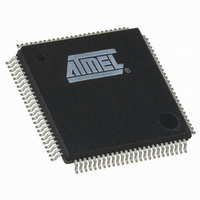AT91SAM7X128B-AU Atmel, AT91SAM7X128B-AU Datasheet - Page 464

AT91SAM7X128B-AU
Manufacturer Part Number
AT91SAM7X128B-AU
Description
IC MCU 128KB FLASH 100LQFP
Manufacturer
Atmel
Series
AT91SAMr
Specifications of AT91SAM7X128B-AU
Core Processor
ARM7
Core Size
16/32-Bit
Speed
55MHz
Connectivity
CAN, Ethernet, I²C, SPI, SSC, UART/USART, USB
Peripherals
Brown-out Detect/Reset, DMA, POR, PWM, WDT
Number Of I /o
62
Program Memory Size
128KB (128K x 8)
Program Memory Type
FLASH
Ram Size
32K x 8
Voltage - Supply (vcc/vdd)
1.65 V ~ 1.95 V
Data Converters
A/D 8x10b
Oscillator Type
Internal
Operating Temperature
-40°C ~ 85°C
Package / Case
100-LQFP
Processor Series
AT91SAMx
Core
ARM7TDMI
Data Bus Width
32 bit
Data Ram Size
32 KB
Interface Type
JTAG, SPI, UART
Maximum Clock Frequency
55 MHz
Number Of Timers
1
Maximum Operating Temperature
+ 85 C
Mounting Style
SMD/SMT
3rd Party Development Tools
JTRACE-ARM-2M, KSK-AT91SAM7X-PL, MDK-ARM, RL-ARM, ULINK2
Development Tools By Supplier
AT91SAM-ICE, AT91-ISP, AT91SAM7X-EK
Minimum Operating Temperature
- 40 C
On-chip Adc
10 bit, 8 Channel
Controller Family/series
AT91SAM7xxxxx
No. Of I/o's
62
Ram Memory Size
32KB
Cpu Speed
55MHz
No. Of Timers
1
Rohs Compliant
Yes
Cpu Family
91S
Device Core
ARM7TDMI
Device Core Size
32b
Frequency (max)
55MHz
Total Internal Ram Size
32KB
# I/os (max)
62
Number Of Timers - General Purpose
3
Operating Supply Voltage (typ)
1.8/3.3V
Operating Supply Voltage (max)
1.95/3.6V
Operating Supply Voltage (min)
1.65/3V
Instruction Set Architecture
RISC
Operating Temp Range
-40C to 85C
Operating Temperature Classification
Industrial
Mounting
Surface Mount
Pin Count
100
Package Type
LQFP
Lead Free Status / RoHS Status
Lead free / RoHS Compliant
Eeprom Size
-
Lead Free Status / Rohs Status
Lead free / RoHS Compliant
Available stocks
Company
Part Number
Manufacturer
Quantity
Price
Company:
Part Number:
AT91SAM7X128B-AU
Manufacturer:
Atmel
Quantity:
1 929
Part Number:
AT91SAM7X128B-AU
Manufacturer:
ATMEL/爱特梅尔
Quantity:
20 000
- Current page: 464 of 687
- Download datasheet (11Mb)
34.5.3.1
34.5.3.2
34.5.3.3
34.5.3.4
34.5.3.5
34.5.3.6
464
SAM7X512/256/128 Preliminary
Not Powered State
Entering Attached State
From Powered State to Default State
From Default State to Address State
From Address State to Configured State
Entering in Suspend State
Self powered devices can detect 5V VBUS using a PIO as described in the typical connection
section. When the device is not connected to a host, device power consumption can be reduced
by disabling MCK for the UDP, disabling UDPCK and disabling the transceiver. DDP and DDM
lines are pulled down by 330 KΩ resistors.
When no device is connected, the USB DP and DM signals are tied to GND by 15 KΩ pull-down
resistors integrated in the hub downstream ports. When a device is attached to a hub down-
stream port, the device connects a 1.5 KΩ pull-up resistor on DP. The USB bus line goes into
IDLE state, DP is pulled up by the device 1.5 KΩ resistor to 3.3V and DM is pulled down by the
15 KΩ resistor of the host.
After pullup connection, the device enters the powered state. In this state, the UDPCK and MCK
must be enabled in the Power Management Controller. The transceiver can remain disabled.
After its connection to a USB host, the USB device waits for an end-of-bus reset. The
unmaskable flag ENDBUSRES is set in the register UDP_ISR and an interrupt is triggered.
Once the ENDBUSRES interrupt has been triggered, the device enters Default State. In this
state, the UDP software must:
In this state UDPCK and MCK must be enabled.
Warning: Each time an ENDBUSRES interrupt is triggered, the Interrupt Mask Register and
UDP_CSR registers have been reset.
After a set address standard device request, the USB host peripheral enters the address state.
Warning: Before the device enters in address state, it must achieve the Status IN transaction of
the control transfer, i.e., the UDP device sets its new address once the TXCOMP flag in the
UDP_CSR[0] register has been received and cleared.
To move to address state, the driver software sets the FADDEN flag in the UDP_GLB_STAT
register, sets its new address, and sets the FEN bit in the UDP_FADDR register.
Once a valid Set Configuration standard request has been received and acknowledged, the
device enables endpoints corresponding to the current configuration. This is done by setting the
EPEDS and EPTYPE fields in the UDP_CSRx registers and, optionally, enabling corresponding
interrupts in the UDP_IER register.
When a Suspend (no bus activity on the USB bus) is detected, the RXSUSP signal in the
UDP_ISR register is set. This triggers an interrupt if the corresponding bit is set in the UDP_IMR
• Enable the default endpoint, setting the EPEDS flag in the UDP_CSR[0] register and,
• Configure the interrupt mask register which has been reset by the USB reset detection
• Enable the transceiver clearing the TXVDIS flag in the UDP_TXVC register.
optionally, enabling the interrupt for endpoint 0 by writing 1 to the UDP_IER register. The
enumeration then begins by a control transfer.
6120I–ATARM–06-Apr-11
Related parts for AT91SAM7X128B-AU
Image
Part Number
Description
Manufacturer
Datasheet
Request
R

Part Number:
Description:
KIT EVAL FOR AT91SAM7X256/128
Manufacturer:
Atmel
Datasheet:

Part Number:
Description:
MCU, MPU & DSP Development Tools KICKSTART KIT ATMEL AT91SAM7X
Manufacturer:
IAR Systems

Part Number:
Description:
MCU ARM9 64K SRAM 144-LFBGA
Manufacturer:
Atmel
Datasheet:

Part Number:
Description:
IC ARM7 MCU FLASH 256K 100LQFP
Manufacturer:
Atmel
Datasheet:

Part Number:
Description:
IC ARM9 MPU 217-LFBGA
Manufacturer:
Atmel
Datasheet:

Part Number:
Description:
MCU ARM9 ULTRA LOW PWR 217-LFBGA
Manufacturer:
Atmel
Datasheet:

Part Number:
Description:
MCU ARM9 324-TFBGA
Manufacturer:
Atmel
Datasheet:

Part Number:
Description:
IC MCU ARM9 SAMPLING 217CBGA
Manufacturer:
Atmel
Datasheet:

Part Number:
Description:
IC ARM9 MCU 217-LFBGA
Manufacturer:
Atmel
Datasheet:

Part Number:
Description:
IC ARM9 MCU 208-PQFP
Manufacturer:
Atmel
Datasheet:

Part Number:
Description:
MCU ARM 512K HS FLASH 100-LQFP
Manufacturer:
Atmel
Datasheet:

Part Number:
Description:
MCU ARM 512K HS FLASH 100-TFBGA
Manufacturer:
Atmel
Datasheet:

Part Number:
Description:
IC ARM9 MCU 200 MHZ 324-TFBGA
Manufacturer:
Atmel
Datasheet:

Part Number:
Description:
IC ARM MCU 16BIT 128K 256BGA
Manufacturer:
Atmel
Datasheet:

Part Number:
Description:
IC ARM7 MCU 32BIT 128K 64LQFP
Manufacturer:
Atmel
Datasheet:











